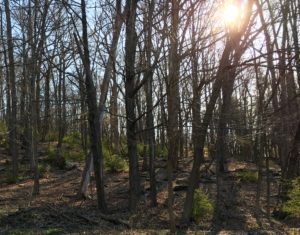Hello fellow lovers of all things green,
When I began as a designer, twenty-five years ago, I thought the prickly green shrubs overtaking forest floors were native, which is not the case. The maroon leaf Japanese Barberry, Berberis thunbergii, has been overused in deer-populated areas for years, though it’s understandable why its popularity persists. They’re tough, their deep red foliage offers a lovely contrast in the garden, and deer don’t eat them. Their slender red berries linger long after the leaves drop, are prized for their ornamental value. Leaves of Berberis thunbergii turn green in shade, which is why the invasive bully is not as obvious to identify in the woodland areas. Thankfully, there are beautiful replacements for invasive plants.

Berberis thunbergii has been overused for years.

Invasive Barberry, taking over forest floors, stays green in shade.
While Barberry is not yet banned here, using it in garden designs nowadays feels irresponsible. New York banned their sale or transport “except the straight ‘Aurea’ variety” (Berberis thunbergii ‘Aurea’, which is lime green), according to Ben Jansen of Jansen’s Nursery in Florida, NY.
Alternatives to Invasive Maiden Grass
Barberry is likely the most popular plant on the NY Department of Environmental Conservation’s (DEC) 2014 list of banned invasive species. Ben went on to explain that Miscanthus sinensis, known as Maiden Grass, was also on the list, but now is only regulated and is still available as long as the DEC label is on the plant. The boldface label is intimidating, declaring the plant as an “Invasive Species – Harmful to the Environment.” Then lists non-harmful alternatives such as Feather Reed Grass (Calamagrostis), Pink Muhly Grass (Muhlenbergia capillaris), and Switch Grass (Panicum virgatum). The label advises, “Do not plant near wild or natural areas. Deadhead or remove seed debris. Do not share seeds, seedlings, or cuttings with other gardeners.”

Smoke Bush and Gold threads allowed to grow into their feathery, full-bodied selves.
Stunning Alternatives to Barberry
There are stunning alternatives to Barberry that are gaining popularity. Dwarf purple-leaved Weigela, such as Weigela florida ‘Wine and Roses’, ‘Midnight Wine’, or ‘Fine Wine’, are gorgeous deer-resistant alternatives. Substitutes for the larger maroon leaf barberry are my favored Smoke Bush, Cotinus coggygria, growing ten to fifteen feet, though manageable with pruning. The smoke-like plumes of flowers give it its common name. Then there’s Eastern Ninebark (Physocarpus opulifolius) – ‘Diablo’, my favorite, which grows four to eight feet tall. You can keep it about four feet tall by cutting it to a foot high each March.
For an alternative to gold Barberry, consider Golden Jackpot Weigela, Weigela florida ‘MonRigney’. Of course, there’s Chamaecyparis pisifera ‘Aurea Nana’ or ‘Golden Mop’. Folks call them Gold Thread Cypress and tend to plant them next to Barberry, chopping them into yellow, maroon, yellow, and maroon meatballs. Instead, may I suggest Gold Threads stand alone and allow them to grow into their feathery, full-bodied selves? Garden Dilemmas? Askmarystone@gmail.com and your favorite Podcast App.
There’s more to the story in the Garden Dilemmas Podcast:
Column updated 7/13/25


